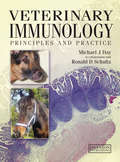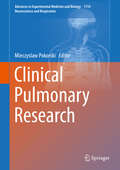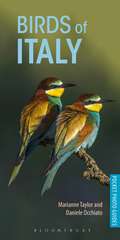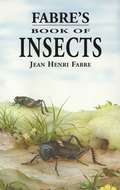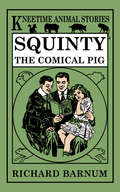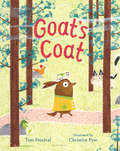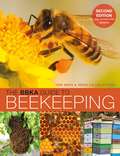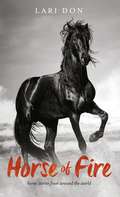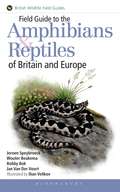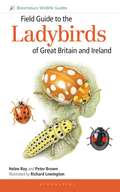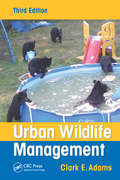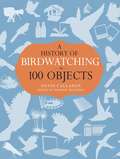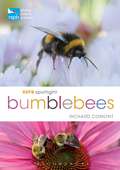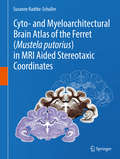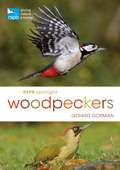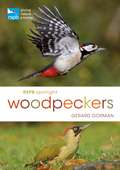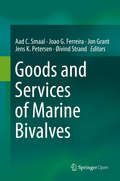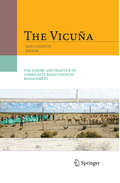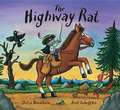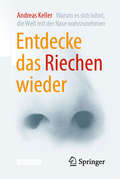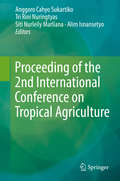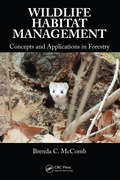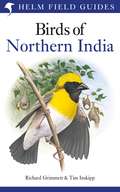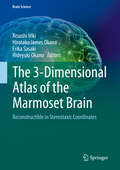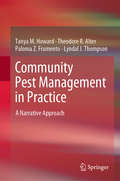- Table View
- List View
Veterinary Immunology: Principles and Practice
by Michael J. DayThis book accompanies and complements the teaching of immunology within the veterinary curriculum. It covers large and small animals, and provides clear learning objectives focusing on immunological principles while applying them to the disease process and to clinical practice. The book is case based and illustrated throughout in color.
Clinical Pulmonary Research (Advances in Experimental Medicine and Biology #1114)
by Mieczyslaw PokorskiThis book describes various aspects of current scientific interest in clinical developments and management of pulmonary pathologies. Non-communicable and communicable disorders are tackled. Chronic disorders of an inflammatory background, such as COPD and asthma, often overlapping, diagnostically and therapeutically misguided and always difficult to manage, are in focus due to an increasing prevalence across the age range. The authors dwell on the disease management, exacerbations, care and therapy, taking into account all too often overlooked psychosomatic determinants. Novel markers of pulmonary sarcoidosis, also an inflammatory disease, albeit of unknown etiology, are described. The outstanding lung images of cystic fibrosis are presented in another chapter. Finally, there are reports on the extent of the influenza scourge in Poland during the past 2016/2017 epidemic season. The book is addressed to clinicians, family physicians, medical scholars, and all professionals engaged in the preservation of respiratory health.
Birds of Italy (Pocket Photo Guides)
by Marianne Taylor Daniele OcchiatoProfiles more than 250 species regularly seen in the region. Authoritative text includes information on identification, songs and calls, behaviour, distribution and habitat. Packed with full-colour photographs, each carefully selected to guide identification. The ideal pocket-sized guide – perfectfor nature-loving travellers and birdwatchers visiting Italy.
Fabre's Book of Insects
by Jean Henri FabreHailed by Darwin as "The Homer of Insects," famed French entomologist Jean Henri Fabre (1823–1915) devoted hours of rapt attention to insects while they hunted, built nests, and fed their families. Working in Provence, in barren, sun-scorched fields inhabited by countless wasps and bees, he observed their intricate and fascinating world, recounting their activities in simple, beautifully written essays.This volume, based on translations of Fabre's Souvenirs Entomologiques, blends folklore and mythology with factual explanation. Fabre's absorbing account of the scarab beetle's existence, for example, begins with the ancient Egyptians' symbolic view of this busy creature, eventually leading to a careful discussion of its characteristic method of rolling a carefully sculpted ball of food to its den. Elsewhere, he discusses with infectious enthusiasm the physiologic secrets behind the luminosity of fireflies, the musical talents of the locust, the comfortable home of the field cricket, and the cannibalism of the pious-looking praying mantis, among other topics.These charmingly related stories of insect life are a rare combination of scientific study and literary classic that will delight entomologists, naturalists, and nature lovers alike.
Squinty, the Comical Pig
by Harriet H. Tooker Richard BarnumSquinty, a brave, bold, mischievous little pig, longs to escape his pen and roam around in the lush green garden - especially the area where the juicy pigweed grows. When Squinty sees his chance, he makes a break for it and sets out on a journey far beyond the garden that's full of surprises, including travels by train and hot air balloon.Before long, Squinty meets Young Bob, who teaches him tricks: finding hidden acorns, jumping across a rope, and standing on his hind legs and marching with a stick like a soldier carrying a rifle. Squinty also encounters Slicko the Squirrel and Mappo the Merry Monkey, other characters from Richard Barnum's heartwarming series of animal adventures.
Goat's Coat
by Tom Percival Christine PymThis charmingly illustrated rhyming picture book about Alfonzo, a goat with a very special coat, celebrates the power of kindness and friendship.Let me tell you the tale of Alfonzo the goat, who was terribly proud of his lovely new coat.Alfonzo was happy; he pranced and he skipped. Then he heard a sad noise, croaking out of a ditch.Alfonzo couldn't be happier. He just got an amazing new coat, and he feels like a million dollars. But when he discovers some creatures in need of help, will Alfonzo be able to give up his treasured possession to save the day?This great big hug of a book shows that kindness is definitely the best recipe.Awards for Tom PercivalHerman's Letter--A Kids' Indie Next List Pick
The BBKA Guide to Beekeeping, Second Edition
by Roger Cullum-Kenyon Ivor DavisThe number of people interested and active in keeping bees at an amateur level has continued to increase over the past few years in both rural and urban situations. This guide, aimed at beginning beekeepers, and the only one to be endorsed by the BBKA provides an authoritative text, along with clear photographs and illustrations.The book introduces the reader to beekeeping, including such areas as the workings of the colony, the structure of a hive, how to acquire bees and keep them healthy and what happens in each month in a beekeeping year.Each chapter is accompanied by anecdotes, answers to frequently asked questions and fascinating facts about bees and honey.The new edition includes new step-by-step sequences to illustrate procedures such as containing a swarm, identifying the queen, using a smoker and cleaning a hive as well as more information on different kinds of hives, disease management and many other key areas.
Horse of Fire: and other stories from around the world
by Lari DonFrom magical winged Pegasus to legendary horses which help their owners in impossible quests, this brilliant selection of folk tales about horses will thrill and entertain. Stories from countries as diverse as Russia and Gambia and traditions as different as the Navajo people and the ancient Greeks make this a really inclusive anthology, perfect for any horse lover.
Field Guide to the Amphibians and Reptiles of Britain and Europe
by Mr Jeroen Speybroeck Mr Wouter Beukema Mr Bobby Bok Mr Jan Van Der Voort Mr Ilian VelikovThe taxonomy and systematics of European reptiles and amphibians have changed a lot in recent years, yet there is no modern, up-to-date field guide available that comprehensively covers all the species. The last illustrated field guide to European reptiles and amphibians was first published 38 years ago, and remains oudated despite occasional reprints and new editions. This major new field guide addresses this deficiency. A total of 219 species are covered in detail, with a focus on identification and geographical variation; species texts also cover distribution, habitat and behaviour. Superb colour illustrations by talented artist Ilian Velikov depict every species and all major variations, and colour photographs are also included for most species.This groundbreaking new guide will become the definitive field reference for these two groups of animals.It includes:- Over 370 colour artworks and 200 colour photographs- 155 accurate and up-to-date distribution maps- Easy-to-use keys and tables to help with swift species identification
Field Guide to the Ladybirds of Great Britain and Ireland (Field Guides)
by Helen Roy Dr Peter Brown Richard Lewington"A ground-breaking identification guide ... the perfect marriage of artistic excellence, deep knowledge and, dare I say it, of scientists' genuine affection." BRETT WESTWOODThis brand new illustrated field guide covers all 47 species of ladybird occurring in the British Isles in a handy and easy-to-use format. Twenty-seven species are colourful and conspicuous and easily recognised as ladybirds; the remaining species are more challenging, but the clear illustrations and up-to-date text in this guide will help to break down the identification barriers. A useful introduction provides an overview of ladybird ecology, tips on studying and recording, and suggested sites for finding ladybirds. The main part of the book comprises detailed species texts, covering field characters, food, habitats, suggested survey methods, ranges, conservation statuses and distribution trends. An illustrated at-a-glance identification guide and helpful pointers for differentiating similar-looking species are also included. With 102 colour photographs and 47 distribution maps, combined with Richard Lewington's peerless artwork, this is the definitive guide to one of our most cherished and charismatic insect groups.
Urban Wildlife Management
by Clark E. AdamsWinner of the 2018 TWS Wildlife Publication Awards in the authored book category Urban development is one of the leading worldwide threats to conserving biodiversity. In the near future, wildlife management in urban landscapes will be a prominent issue for wildlife professionals. This new edition of Urban Wildlife Management continues the work of its predecessors by providing a comprehensive examination of the issues that increase the need for urban wildlife management, exploring the changing dynamics of the field while giving historical perspectives and looking at current trends and future directions. The book examines a range of topics on human interactions with wildlife in urbanized environments. It focuses not only on ecological matters but also on political, economic, and societal issues that must be addressed for successful management planning. This edition features an entirely new section on urban wildlife species, including chapters on urban communities, herpetofauna, birds, ungulates, mammals, carnivores, and feral and introduced species. The third edition features Five new chapters 12 updated chapters Four new case studies Seven new appendices and species profiles 90 new figures A comprehensive analysis of terrestrial vertebrate locations by state and urban observations Each chapter opens with a set of key concepts which are then examined in the following discussions. Suggested learning experiences to enhance knowledge conclude each chapter. The species profiles cover not only data about the animal concerned but also detail significant current management issues related to the species. An updated and expanded teaching tool, Urban Wildlife Management, Third Edition identifies the challenges and opportunities facing wildlife in urban communities as well as factors that promote or threaten their presence. It gives both students and professionals a solid grounding in the required fundamental ecological principles for understanding the effects of human-made environments on wildlife.
A History of Birdwatching in 100 Objects
by Dominic Mitchell David CallahanThis book looks at 100 items that have profoundly shaped how people watched, studied and engaged with the avian world. Each item contains around 500 words on a double-page spread and include an illustration of the object in question. The book includes the objects listed below as well as many more.The range of items is international and cross-cultural. Subjects include:An Egyptian 'field guide' [early tomb decorations of birds, identifiable as species]Ornithologiae libri tres: the first British bird guide [a 1676 publication that attempted to itemise all British birds known at the time]The Dodo specimen held at the Horniman museumSystema Naturae by Carl Linnaeus [the first-ever system of scientific names in 1758, and still the international standard today]The shotgunThe book, The Natural History and Antiquities of Selborne by Gilbert White [1789]HMS Beagle [the ship on which Darwin made his ground-breaking discoveries]Aluminium bird rings [used to record movement and longevity of individuals and species]along with many more modern innovations including walkie talkies, pagers, radio tags and apps.
RSPB Spotlight Bumblebees
by Richard ComontBumblebees are some of our most familiar insects, and are among the few that are almost universally viewed as 'friendly' – their low buzzing is the quintessential sound of our gardens in the summertime.Spotlight Bumblebees considers all 24 UK bumblebee species, examining what made the group so successful and how circumstances have led to the survival of some species but the precipitous decline of the majority, highlighting the dangers we all face if populations continue to plummet. Separate chapters cover all aspects of bumblebees' biology and lifestyles, from spring queens emerging from dark overwintering chambers to establish their nests, to the drone swarms that herald the end of the bumblebee season. Bumblebees around the world are studied, including in the southern hemisphere where Europe's declining species can become harmful invaders. While the influence of bumblebees throughout our history and their place in our culture, from Shakespeare to Transformers, is also examined.
Cyto- and Myeloarchitectural Brain Atlas of the Ferret (Mustela putorius) in MRI Aided Stereotaxic Coordinates
by Susanne Radtke-SchullerDescriptionThis stereotaxic atlas of the ferret brain provides detailed architectonic subdivisions of the cortical and subcortical areas in the ferret brain using high-quality histological material stained for cells and myelin together with in vivo magnetic resonance (MR) images of the same animal. The skull-related position of the ferret brain was established according to in vivo MRI and additional CT measurements of the skull. Functional denotations from published physiology and connectivity studies are mapped onto the atlas sections and onto the brain surface, together with the architectonic subdivisions. High-resolution MR images are provided at levels of the corresponding histology atlas plates with labels of the respective brain structures. The book is the first atlas of the ferret brain and the most detailed brain atlas of a carnivore available to date. It provides a common reference base to collect and compare data from any kind of research in the ferret brain.Key Features Provides the first ferret brain atlas with detailed delineations of cortical and subcortical areas in frontal plane. Provides the most detailed brain atlas of a carnivore to date. Presents a stereotaxic atlas coordinate system derived from high-quality histological material and in vivo magnetic resonance (MR) images of the same animal. Covers the ferret brain from forebrain to spinal cord at intervals of 0.6 mm on 58 anterior-posterior levels with 5 plates each. Presents cell (Nissl) stained frontal sections (plate 1) and myelin stained sections (plate 2) in a stereotaxic frame. Provides detailed delineations of brain structures and their denomination on a Nissl stained background on a separate plate (3). Compiles abbreviations on plate 4, a plate that also displays the low resolution MRI of the atlas brain with the outlines of the Nissl sections in overlay. Displays high-resolution MR images at intervals of 0.15 mm from another animal with labeled brain structures as plate 5 corresponding to the anterior-posterior level of each atlas plate. Provides detailed references used for delineation of brain areas. Target audience of the book: The book addresses researchers and students in neurosciences who are interested in brain anatomy in general (e.g., for translational purposes/comparative aspects), particularly those who study the ferret as important animal model of growing interest in neurosciences.
RSPB Spotlight Woodpeckers
by Gerard GormanWoodpeckers are fascinating birds, filling our forests with their unmistakable drumming, and capturing our imaginations with their incredible ability to drill holes in trees and their bright, colourful plumage. Three species of woodpecker are resident in the UK: the Green Woodpecker, often seen on lawns and in fields; the Great Spotted Woodpecker, a frequent visitor at garden bird-feeders; and the tiny Lesser Spotted Woodpecker, sadly now in decline. The Wryneck – which twists its neck 'like a snake' when threatened – also passes through the UK on its yearly migration and has captivated people throughout the ages. Gerard Gorman provides a close-up look at the lives of these birds, from their anatomy, diet and nesting habits to their iconic drumming behaviour. He also explores the relationship that humans have enjoyed with woodpeckers for centuries, in folklore, myth and conservation, and gives tips on how to observe these wonderful birds in the wild. The Spotlight series introduces readers to the lives and behaviour of our favourite animals with eye-catching colour photographs and informative expert text.
RSPB Spotlight Woodpeckers
by Gerard GormanWoodpeckers are fascinating birds, filling our forests with their unmistakable drumming, and capturing our imaginations with their incredible ability to drill holes in trees and their bright, colourful plumage. Three species of woodpecker are resident in the UK: the Green Woodpecker, often seen on lawns and in fields; the Great Spotted Woodpecker, a frequent visitor at garden bird-feeders; and the tiny Lesser Spotted Woodpecker, sadly now in decline. The Wryneck – which twists its neck 'like a snake' when threatened – also passes through the UK on its yearly migration and has captivated people throughout the ages. Gerard Gorman provides a close-up look at the lives of these birds, from their anatomy, diet and nesting habits to their iconic drumming behaviour. He also explores the relationship that humans have enjoyed with woodpeckers for centuries, in folklore, myth and conservation, and gives tips on how to observe these wonderful birds in the wild. The Spotlight series introduces readers to the lives and behaviour of our favourite animals with eye-catching colour photographs and informative expert text.
Goods and Services of Marine Bivalves
by Øivind Strand Jens K. Petersen Jon Grant Joao G. Ferreira Aad C. SmaalThe aim of this book is to review and analyse the goods and services of bivalve shellfish. How they are defined, what determines the ecological functions that are the basis for the goods and services, what controversies in the use of goods and services exist, and what is needed for sustainable exploitation of bivalves from the perspective of the various stakeholders. The book is focused on the goods and services, and not on impacts of shellfish aquaculture on the benthic environment, or on threats like biotoxins; neither is it a shellfish culture handbook although it can be used in evaluating shellfish culture. The reviews and analysis are based on case studies that exemplify the concept, and show the strengths and weaknesses of the current applications. The multi-authored reviews cover ecological, economic and social aspects of bivalve goods and services. The book provides new insights for scientists, students, shellfish producers, policy advisors, nature conservationists and decision makers. This book is open access under the CC BY license.
The Vicuña: The Theory And Practice Of Community Based Wildlife Management (PDF)
by Iain Gordon Jerry Laker Gabriela Lichtenstein Desmond McNeill Kristi Anne Stølen Bibiana Vilá Ana Wawrzyk Jane C. Wheeler Hugo Yacobaccio Renaudeau D' Arc Nadine Yanina Arzamendia Verónica Benítez Cristian Bonacic Mariela Borgnia Marcelo Cassini Jessica Gimpel Pete Goddard Javier García GomezNo synopsis available.
The Highway Rat (PDF)
by Julia Donaldson Axel Scheffler"Give me your buns and your biscuits! Give me your chocolate éclairs! For I am the Rat of the highway, and the Rat Thief never shares!" You may have heard of a Highwayman - but what about a Highway Rat? No food is safe from this rascally rodent! He steals clover from a rabbit, and snaffles nuts from a squirrel. He even hijacks his own horse's hay! But when a cunning duck crosses his path, has the Highway Rat met his match? Put your hands up for this rhyming romp from the current Children's Laureate, starring a wickedly loveable baddie who'll steal your grub - and your heart!
Entdecke das Riechen wieder: Warum Es Sich Lohnt, Die Welt Mit Der Nase Wahrzunehmen
by Andreas KellerWarum es sich lohnt, die Welt mit der Nase wahrzunehmenEntdecke das Riechen wieder riecht wie alle anderen Bücher, aber nachdem Sie es gelesen haben, werden Bücher und vieles andere für Sie nicht mehr so riechen wie zuvor. Ob es bei Menschen Pheromone gibt, warum es so schwierig ist, über Gerüche zu reden, welches Tier den besten Riecher hat und warum manche Menschen den Geruch von Spargel-Urin nicht riechen können - das sind nur einige der Fragen, die der Geruchsforscher Andreas Keller in diesem Buch beantwortet. Menschen besitzen eine gute Nase, haben aber im Laufe der Evolution mehr und mehr verlernt, sie zu benutzen. Dieses Buch wird Sie überzeugen, dass Riechen nicht so mysteriös ist, wie oft angenommen, und dass es sich lohnt, die Welt wieder (auch) mit der Nase wahrzunehmen. In einem Zeitalter, das von digitalisierten Erfahrungen geprägt ist, die beliebig kopiert und für die Ewigkeit gespeichert werden können, bedeutet die flüchtige Realität eines Geruches mehr als je zuvor.
Proceeding of the 2nd International Conference on Tropical Agriculture
by Anggoro Cahyo Sukartiko Tri Rini Nuringtyas Siti Nurleily Marliana Alim IsnansetyoThis book covers the sustainable tropical agriculture, sustainable tropical animal production and health, sustainable tropical forestry, socio-economic dimension in tropical agriculture and innovative and emerging food technology and management as chapters in this book. The common challenging problems in plant, animal, and fisheries production in the tropic are climate change, inefficiency production system, low technological innovation, decreasing environment quality, and the outbreak risk of pest and diseases.
Wildlife Habitat Management
by Brenda C. McCombIn recent years, conflicts between ecological conservation and economic growth forced a reassessment of the motivations and goals of wildlife and forestry management. Focus shifted from game and commodity management to biodiversity conservation and ecological forestry. Previously separate fields such as forestry, biology, botany, and zoology merged
Birds of Northern India (Helm Field Guides Ser.)
by Richard Grimmett Tim InskippA successor to Birds of the Indian Subcontinent", by the same authors, this handbook explores the birdlife of northern India and Pakistan. The plates are accompanied by text that highlights the identification, voice, habitat, altitudinal range, distribution and status of the birds. The text is on pages facing the plates for easy reference, and there are distribution maps for every species."
The 3-Dimensional Atlas of the Marmoset Brain: Reconstructible In Stereotaxic Coordinates (Brain Science)
by Atsushi Iriki Hirotaka James Okano Erika Sasaki Hideyuki OkanoThis book provides accurate, comprehensive, and convenient reference for usages of the “freely rotatable three dimensional combined Nissl-stained and MRI digital data of the marmoset brain”. The key features of the original 3D digital data and of this atlas are: 1. The original digital datasets are freely rotatable in three dimensions, thus expected to be useful for any disciplines and anatomical interest, using any coordinate system, 2. Combined Nissl stained and MRI images are obtained from the same marmoset, to allow cross-modality matched references for multiple usages, 3. 86 Horizontal Series of Images with Neurosurgical Plane (based on the actual data), with more accuracy and resolution (Chapter 2) than the web-based digital images, 4. 32 Coronal Series of Images with Neurosurgical Plane (reproduced from the brain model) (Chapter 3), 5. 10 Parasagittal Series of Images with Neurosurgical Plane (reproduced from the brain model) (Chapter 4), 6. 3 Omnidirectionally Sliceable Planes (reproduced from the brain model) (Chapter 5), 7. In order to provide higher resolution structures to match systematic accuracy for supplementation of the digital data on the website, additional information are included. They are: 1) Nomenclature, 2) List of Brain Structures in Hierarchical Order, 3) Index of Abbreviations, together with 143 useful Bibliographic References list as of 2016, 8. Horsley-Clarke’s stereotaxic coordinates were adopted in the present atlas.
Community Pest Management in Practice: A Narrative Approach
by Tanya M. Howard Theodore R. Alter Paloma Z. Frumento Lyndal J. ThompsonThis book presents a collection of practitioner and community stories that reveal how invasive species management is a community issue that can spark community formation and collective action. It combines the unique first-person narratives of practitioners on the frontline of invasive species management in Australia with three case studies of community action for wild dog management across a range of geographical landscapes. The book offers readers a new understanding of how communities are formed in the context of managing different species, and how fundamental social and political processes can make or break landholders’ ability to manage invasive species. Using narrative analysis of practitioner profiles and community groups, drawing lessons from real-world practices, and employing theories from community development, rural sociology and collective action, this book serves multiple functions: it offers a teaching tool, a valuable research contribution, and a practitioner’s field guide to pursuing effective community development work in connection with natural resource management, wildlife management and environmental governance.
